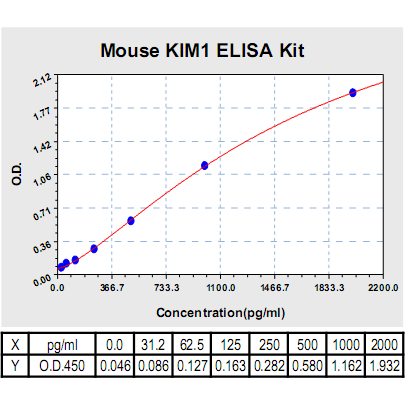KIM-1 ELISA Kit, Mouse |
 |
BACKGROUND The kidney injury molecule-1 (KIM-1) is a type I cell membrane glycoprotein which contains, in its extracellular portion, a novel six-cysteine immunoglobulin-like domain, two N-glycosylation sites and a T/SP rich domain characteristic of mucin-like O-glycosylated proteins. The structure of the protein showes adhesion molecule properties. KIM-1 is not normally present, but is expressed on the proximal tubule apical membrane with injury. KIM-1 is also expressed at high levels in patients with clear cell-type renal cell carcinoma (RCC). RCC, like renal tubular injury, is associated with proximal tubule cell dedifferentiation. It may participate in the progress of renal injury or repair. The ectodomain of KIM-1 is shed from cells. A soluble form of human KIM-1 can be detected in the urine of patients with acute tubular necrosis (ATN) and may serve as a useful biomarker for renal proximal tubule injury facilitating the early diagnosis of the disease and serving as a diagnostic discriminator.1
Many studies have illustrated the different functions of KIM-1 in various renal diseases including protective functions in acute kidney injury and damaging functions in chronic kidney disease. KIM-1 confers on epithelial cells the ability to recognize and phagocytose dead cells that are present in the post-ischaemic kidney and contribute to the obstruction of the tubule lumen that characterizes acute kidney injury (AKI).2 KIM-1 is a phosphatidylserine receptor that recognizes apoptotic cells directing them to lysosomes. It also serves as a receptor for oxidized lipoproteins and hence is adept at recognizing apoptotic cell ‘eat me’ signals. Given these properties KIM-1 is unique in being the first non-myeloid phosphatidylserine receptor that transforms epithelial cells into semi-professional phagocytes. In addition to the facilitation of clearance of the apoptotic debris from the tubular lumen, KIM-1 may play an important role in limiting the autoimmune response to injury since it is known in many systems that phagocytosis of apoptotic bodies is one mechanism for limiting the proinflammatory response. Acute protective responses, however, may not necessarily translate to chronic effects of KIM-1 expression, a clinically relevant issue, since it has been shown that many individuals with chronic renal failure express the KIM-1 protein in their proximal tubules. KIM-1 is expected to be a therapeutic target for kidney injury.3 In addition, KIM-1 is receptor for TIMD4. In case of human hepatitis A virus (HHAV) infection, it functions as a cell-surface receptor for the virus (HAVCR).
Many studies have illustrated the different functions of KIM-1 in various renal diseases including protective functions in acute kidney injury and damaging functions in chronic kidney disease. KIM-1 confers on epithelial cells the ability to recognize and phagocytose dead cells that are present in the post-ischaemic kidney and contribute to the obstruction of the tubule lumen that characterizes acute kidney injury (AKI).2 KIM-1 is a phosphatidylserine receptor that recognizes apoptotic cells directing them to lysosomes. It also serves as a receptor for oxidized lipoproteins and hence is adept at recognizing apoptotic cell ‘eat me’ signals. Given these properties KIM-1 is unique in being the first non-myeloid phosphatidylserine receptor that transforms epithelial cells into semi-professional phagocytes. In addition to the facilitation of clearance of the apoptotic debris from the tubular lumen, KIM-1 may play an important role in limiting the autoimmune response to injury since it is known in many systems that phagocytosis of apoptotic bodies is one mechanism for limiting the proinflammatory response. Acute protective responses, however, may not necessarily translate to chronic effects of KIM-1 expression, a clinically relevant issue, since it has been shown that many individuals with chronic renal failure express the KIM-1 protein in their proximal tubules. KIM-1 is expected to be a therapeutic target for kidney injury.3 In addition, KIM-1 is receptor for TIMD4. In case of human hepatitis A virus (HHAV) infection, it functions as a cell-surface receptor for the virus (HAVCR).
REFERENCES
1. Han, W.K. et al: Kidney Int. 62:237-44, 2002
2. Bonventre, J.V.: Scand. J. Clin. Lab. Invest. Suppl. 241:78-83, 2008
3. Huo, W. et al: Transplant. Rev. (Orlando) 24:143-6, 2010
2. Bonventre, J.V.: Scand. J. Clin. Lab. Invest. Suppl. 241:78-83, 2008
3. Huo, W. et al: Transplant. Rev. (Orlando) 24:143-6, 2010
Products are for research use only. They are not intended for human, animal, or diagnostic applications.
Параметры
Cat.No.: | CL0880 |
Target Protein Species: | Mouse |
Range: | 31.2pg/ml-2000pg/ml |
Specificity: | No detectable cross-reactivity with any other cytokine. |
Storage: | Store at 4°C. Use within 6 months. |
ELISA Kits are based on standard sandwich enzyme-linked immunosorbent assay technology. Freshly prepared standards, samples, and solutions are recommended for best results.
Документы
Информация представлена исключительно в ознакомительных целях и ни при каких условиях не является публичной офертой








